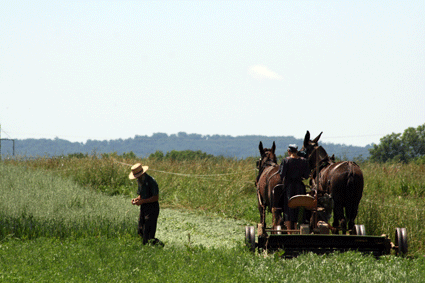Having had a brief visit to an Amish and Mennonite area of Pennsylvania during a trip to the US earlier this summer, I watched with interest a recent documentary on Channel 4 here in the UK entitled Amish: World’s Squarest Teenagers.
The premise was simple: five Amish teenagers leaving their close-knit communities in America for the very first time, to travel to Britain on a cultural exchange.
The conservative dress and staunch religious beliefs of the Amish youngsters were viewed with a mixture of surprise and interest by the British teenagers they met. But, as is often the case when people from very different places meet in person, they found far more common ground than they might have expected and gradually came to accept and respect each other’s views and lifestyles.
For me this is the most valuable thing that travel teaches us. It opens our eyes to new ideas and perspectives. It reminds us not to always believe our view of the world is the right – or best – one.
I’d visited the Lancaster County communities of Bird-in-Hand and Intercourse – the latter’s name derives from the fact that it grew up on an crossroads, although of course it’s name does raise a chuckle or two for some… according to Wikipedia the town’s signposts are “frequently targeted by thieves”. A few souvenir postcards from Intercourse were enough for me, however.
The film Witness, which starred Harrison Ford and Kelly McGillis, was filmed in and around the village. Yet while this pretty heartland of ‘Amish Country’ allows visitors to take horse-and-buggy rides and learn about Amish culture from friendly locals, it’s by no means overrun with tourist hordes, thankfully.
Taking a buggy tour I was interested to learn that as many as 90 per cent of Amish youth decide to join the church after Rumspringa, or ‘running around’. This is a time when Amish youngsters are allowed more freedom for a year or perhaps several years during their late teens and early twenties. It’s a chance to see the wider world, wear non-Amish clothes, watch movies and drive cars if they choose – or, more often than not, to spend time with their peers in their own communities before making the commitment to join the church through baptism. They will then dress as Amish and adhere to the rules of the church for the rest of their adult lives.
It was a warm summer day and the sun shone brightly across the undulating green landscape of Intercourse. Washing, hung out to dry on lines outside farmhouse, swayed gently in the breeze. Fields of hay and maize were being harvested with the help of horses. I noticed one farmer dozing gently as his horse walked in front, his head nodding beneath a felt hat, now and then, to the slow rhythm of the task at hand.
Many things are done according to the old ways, but that’s not to say that technology doesn’t feature at all in Amish life. In some homes the cookers, fridges, some tools and farming equipment are state-of-the-art. But connectivity, I learn, is the important thing: power comes from generators and batteries rather than the grid. This has also allowed some Amish to start using mobile phones, as they’re ‘not connected’.
It was through this that one of the Amish girls in the TV series had contacted her mother while she was in Cornwall staying with some young English surfers. Having never seen the sea before she wanted to try this exiting but totally unfamiliar sport, but was concerned about the figure-hugging wetsuit that she would have to wear, which went against her Amish principles. Her mother wanted her daughter to experience as much as she could on this once-in-a-lifetime trip and wisely suggested a solution.
“Why not wear a T-shirt over the top,” she suggested.
‘Good on her Mum’, I thought. She gets it, she understands. Travel really can give us a great education.










